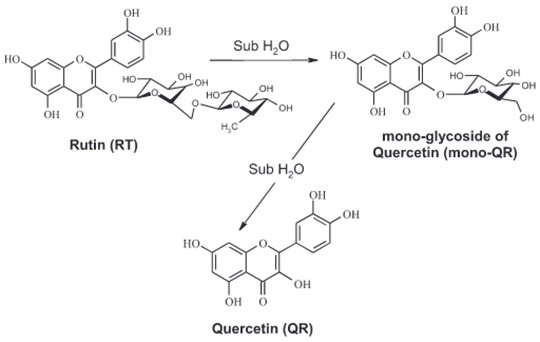
Evaluation of different extraction techniques for the assay of anti - acetylcholinesterase activity of olive leaves (Olea europaea)
Abstract
The total phenol content and the anti-acetylcholinesterase activity were compared in olive leaf (OL) extracts obtained using both subcritical water extraction (SbWE) and conventional solvent extraction (ethanol-water). The method proposed by Ellman (in vitro) was used to study the inhibitory activity of acetylcholinesterase (AChE). The total content of phenolic compounds and AChE activities of OL extracts varied depending on the used extraction method. Thus, the extract obtained using the subcritical water technique (220 °C) showed the highest amounts of total phenolic components, expressed as gallic acid equivalents, (70.4 mg/g raw material) and the highest inhibitory AChE-activity (IC50 = 0.35 mg/ml). The obtained values of the anti-AChE activity of the extracts of OL demonstrated that the inhibitory activity for SbW-extract 120 °C (IC50 = 2.92 mg/ml) and SbW-extract 180 °C (IC50 = 0.8 mg/ml) is higher than that of the traditional extract (IC50 = 3.6 mg/ml), respectively. These results indicate a great potential of the subcritical water technique to develop the techniques to produce commercial extracts of OL, and these results could encourage improved utilization of the OL. The collected data on the anti - acetylcholinesterase activity of olive leaves clearly demonstrate the prospects for use of OL extracts in the development of novel pharmaceutical substances and nutraceuticals for the prevention and/or the treatment of Alzheimer's disease as well as some other neurodegenerative diseases.
Keywords
Full Text:
PDFReferences
Mahadik VJ, Chavare MN, Patil SS, Wadkar KA. Cognition Enhancing potential of Sesbania grandiflora fruit extract in Scopolamine induced Amnesia in mice. Res J Pharm Tech-nol. 2020;13(11):5057–62. doi:10.5958/0974-360X.2020.00886.0
Sharma VK. Current Therapeutic Strategies for Alzheimer’s disease: A Lost Direction or A Hope Remains? Res J Pharm Pharmacodynamics. 2010;2(3):215–20. Available from: https://www.researchgate.net/publication/343682407_Current_Therapeutic_Strategies_for_Alzheimer%27s_disease_A_Lost_Direction_or_A_Hope_Remains
Savateev KV, Borisov SS, Voinkov EK, Ulomsky EN, Rusinov VL, Chupakhin ON. 6-Aminotriazolo[1,5-a]pyrimidines as precursors of 1,2,4-triazolo[5,1-b]purines. Chimica Techno Acta. 2015;2(2):127–30. doi:10.15826/chimtech.2015.2.2.013
Dhinakaran S, Tamilanban T, Chitra V. Targets for Alz-heimer’s Disease. Res J Pharm Technol. 2019;12(6):3073–77. doi:10.5958/0974-360X.2019.00521.3
Kumar DR, Shankar MS, Reddy PP, Kumar B, Sumalatha N. A Review on Alzheimer’s Disease. Res J Pharm Pharmacody-namics. 2014;6(1):59–63. Available from: https://rjppd.org/AbstractView.aspx?PID=2014-6-1-24
Srikanth Y, Tamilanban T, Chitra V. Medicinal plants Tar-geting Alzheimer’s disease-A Review. Res J Pharm Technol. 2020;13(7):3454–58. doi:10.5958/0974-360X.2020.00613.7
Galkin AA, Lunin VV. Subcritical and supercritical water: a universal medium for chemical reactions. Russ Chem Rev. 2005;74(1):21–35. doi:10.1070/RC2005v074n01ABEH001167
Maksimenko EV, Khizrieva SS, Borisenko SN, Lekar AV, Borisenko NI, Minkin VI. Subkriticheskaya voda kak in-strument dlya polucheniya oleanolovoy kisloty iz list’’ev olivy (Olea Europaea L.) Supercrit. fluids: Theory and prac-tice. 2020;15(4):68–73. doi: 10.34984/SCFTP.2020.15.4.006
Yaschenko NN, Zhitar SV, Zinovjeva EG. Determination of phenolic compounds in medicinal preparations by gal-vanostatic coulometry. Chimica Techno Acta. 2021;8(1):20218110. doi:10.15826/chimtech.2021.8.1.10
Vogel P, Machado IK, Garavaglia J, Zani VT, de Souza D, Dal Bosco SM. Polyphenols benefits of olive leaf (Olea europaea L) to human health. Nutr. Hosp. 2015;31(3):1427–33. doi:10.3305/nh.2015.31.3.8400
Omar SH, Scott CJ, Hamlin AS, Obied HK. Biophenols: En-zymes (β-secretase, Cholinesterases, histone deacetylase and tyrosinase) inhibitors from olive (Olea europaea L.). Fitoterapia. 2018;128:118–29. doi:10.1016/j.fitote.2018.05.011
Tutelian VA, Eller KI, Aleshko-Ozhevsky YP. Rukovodstvo po metodam kontrolya kachestva i bezopasnosti biologicheski aktivnykh dobavok k pishche [Guidance on methods for quality control and safety of bioactive food additives]. Mos-cow: Federal Center for State Sanitary and Epidemiological Supervision of the Ministry of Health of Russia; 2004. 240 p. Russian.
Ellman GL, Courtney KD, Andres JrV, Featherstone RM. A new and rapid colorimetric determination of acetylcholin-esterase activity. Biochem Pharm. 1961;7(2):88–95. doi:10.1016/0006-2952(61)90145-9
Vetrova EV, Maksimenko EV, Khizrieva SS, Bugaeva AF, Borisenko NI, Minkin VI. A simple way for the preparation of natural antioxidant quercetin from rutin by subcritical water. Journal of natural science, biology, and medicine. 2017;8(2):213–215. doi:10.4103/0976-9668.210009
Maksimenko EV, Lekar AV, Borisenko SN, Khizrieva SS, Vetrova EV, Borisenko NI, Minkin VI. The development of a one-step method for production of the antioxidant querce-tin from flower buds of the Sophora japonica (Sophora ja-ponica L.) in a subcritical water medium. Russ J Phys Chem B. 2018;12(8):1269–75. doi:10.1134/S1990793118080092
Maksimenko EV, Lekar AV, Khizrieva SS, Borisenko SN, Vetrova EV, Borisenko NI, Minkin VI. Novel eco-friendly “One-Pot” facile strategy for production of the natural quercetin from the plant: A model study. J Nat Sci Biol Med. 2018;9(2):278–81. doi:10.4103/jnsbm.JNSBM_161_17
Ademosun AO, Oboh G, Bello F, Ayeni PO. Antioxidative properties and effect of quercetin and its glycosylated form (Rutin) on acetylcholinesterase and butyrylcholinesterase activities. J Evid. Based Complementary Altern. Med. 2016;21(4):NP11–7. doi:10.1177/2156587215610032
DOI: https://doi.org/10.15826/chimtech.2021.8.4.03
Copyright (c) 2021 S.S. Khizrieva, S.N. Borisenko, E.V. Maksimenko, N.I. Borisenko

This work is licensed under a Creative Commons Attribution 4.0 International License.
Chimica Techno Acta, 2014–2025
eISSN 2411-1414
Copyright Notice







